It’s a commonly held view that economic growth is desirable. A higher GDP per capita, which is the typical measure of such growth, enables improvements in social welfare across the board. It also gives more people the ability to afford the products of the economy in question.
However, contemporary development analysts have raised whether economic growth should always be an unquestioned objective of society. After all, growth incurs costs. These include challenges to the distribution of wealth, resulting in growing inequality if not addressed, or increased strain on social relationships and systems.
The highest cost of growth, and the one with the most obvious impact, is waste generation. And as we face a global crisis related to climate change and environmental degradation, rising production must be accompanied by better-designed waste management solutions.
Minimizing waste
All living things must tackle the issue of waste management. Thus, nature provides ample evidence of the positive correlation between growth and waste.
Even on a cellular level, organisms have evolved mechanisms to eliminate the toxic byproducts of metabolism and respiration. Those mechanisms become more complex in multicellular organisms. Larger animals generate more waste than smaller ones, as do adults compared to their young.
In economic terms, it’s no different. The EPA notes that since the Great Recession, US production trends have steadily increased, and so has the corresponding amount of production-related waste generated by our manufacturing sector.
The most direct interventions any manufacturer can make are “lean and clean,” focused on minimizing waste. These have the obvious benefit of improving efficiency, and therefore the bottom line. They are the low-hanging fruit of production waste management.
Consider a facility producing beverages. By installing drip-free nozzles for dispensing fluids, the loss of product can be avoided. Redesigning the packaging to a more compact shape, using more recyclable materials such as biodegradable liquid cartons, is another way to trim waste generation.
But at some point, those beverages must still be handled by humans. Machine-based upgrades can’t help with spillage resulting from human clumsiness in shipping and handling. End-user behaviors such as awareness of expiration dates or willingness to recycle also play a part in determining how and why a product might ultimately end up as waste.
Closing the loop
The beverage example illustrates the limitations of an approach focusing solely on waste minimization. And these diminishing returns apply to any form of production that relies on a linear economy.
Linear production has been the default model for decades, even centuries, in any industry. Companies extract resources, use those inputs to manufacture products, and generate waste.
It’s this manner of “take, make, waste” operation that scales so poorly with the economic growth we find so desirable.
What we really want is a solution that can uncouple waste generation from the process of growth so that increasing economic productivity doesn’t lead to a proportionate increase in waste.
The alternative model encouraged by policy-makers and conservationists worldwide is described as closed-loop production or a circular economy. It requires manufacturers to tighten the gaps throughout the supply chain and in all stages of production by ensuring that wastes don’t simply go to landfills or get incinerated.

Design-based interventions
In closed-loop manufacturing, you strive for circularity by finding a viable purpose for every form of waste generated in the production process.
This, in turn, places a greater emphasis on the design stage of your operations. You can’t simply continue running a linear production model and attempt to find new uses for the wastes produced. Often, those byproducts are wasteful as a result of the way the process itself works.
Rethinking production design opens up a much broader range of options for reducing net waste. You can experiment with new materials that are benign or non-toxic. You might avoid environmental degradation by switching from raw resource extraction to secondary sources or finding the lowest suitable grade of material to work with.
In addition to the common approach of “lean and clean” manufacturing, you can explore ways to reintegrate products that have been returned for defects or damage. Designers can also attempt to lengthen the product’s longevity by improving the technical specifications and quality or adding value and enhancing aesthetics that foster consumer attachment.
For every manufacturer and type of product, there will be some things that work and others that don’t. Remember that design is an iterative process and must be tailor-fit to your unique position. Maybe the loop won’t be perfectly closed, but as long as you work with a cradle-to-cradle mindset, you can help boost growth with minimal related waste.

